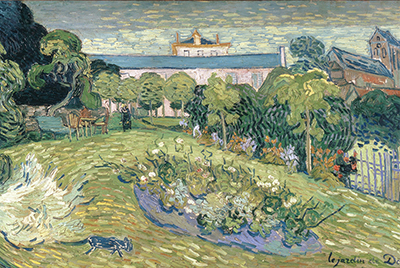In May 1890 Vincent Van Gogh moved to the quiet Parisian suburb of Auvers, a place where many artists had taken up residence before, including the Barbizon school painter Charles-Francois Daubigny.
Van Gogh had always admired Daubigny's work, seeing his own love of nature depicted in the landscapes Daubigny painted. On hearing of Daubigny's death in 1878 Van Gogh had written a letter to his brother Theo in which he writes about how downcast he was on hearing the sad news. Van Gogh was able to paint the garden during his time at Auvers as the house was still occupied by Daubigny's widow who gave him permission.
Van Gogh painted Daubigny's Garden on a double-squared canvas, using natural tones to stay true to the style of Daubigny. Pink, green and violet bring the early summer flowers and grass depicted to vivid life. Outdoor chairs and a table are set to the left of the garden landscape to illustrate this is a garden to relax in and enjoy. Towards the back of the painting is a woman, probably Daubigny's widow, while a black cat features at the front, parallel to the more distant woman. The rose bed is the dominant feature placed centrally in the foreground, while the large house and a church with a Romanesque steeple are prominent as they stand over the garden in the background.
The painting can be seen at the Kunstmuseum in Basel in Switzerland and was one of three depictions of the garden Van Gogh made during the early summer of 1890. The first was a sketch of the garden while the third was another painting on double-square canvas, but this time without the cat in the foreground which Van Gogh gave to Daubigny's widow. Van Gogh killed himself not long after he painted Daubigny’s Garden and one line of thought sees the black cat in the painting as representing Van Gogh and its removal in the third picture indicated the decision he had already made to end his life.
For an artist who only sold one painting during his lifetime, Vincent van Gogh's influence over the years has been remarkable. A post-impressionist painter, he produced in excess of 2100 artworks during his lifetime. Yet his country upbringing in Brabant produced a love of nature, a passion he saw replicated within the work of Daubigny. Vincent Van Gogh left a clinic in San Remy to move to Auvers, where he could be closer to his brother Theo, as well as French physician Dr Paul Gachet of whom he painted several portraits. Van Gogh’s time in Auvers was cut tragically short, but he is recognised for his work there to this day with a statue depicting him with his paints and easel as if about to head out to find another worthy Auvers location to paint.




